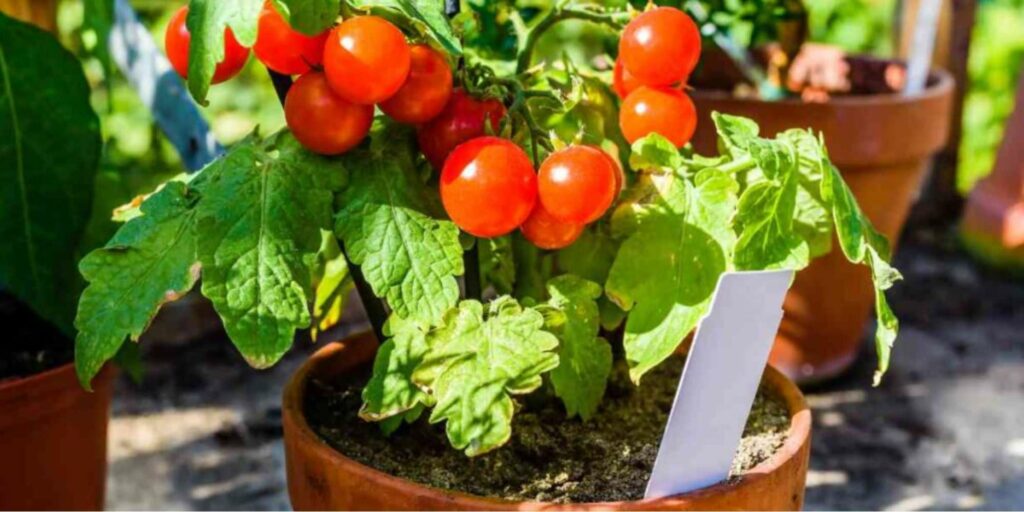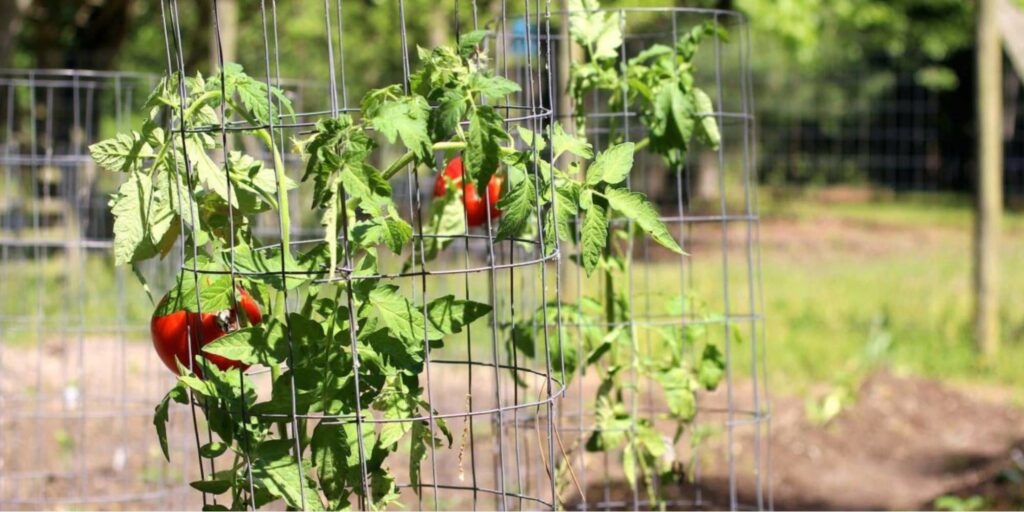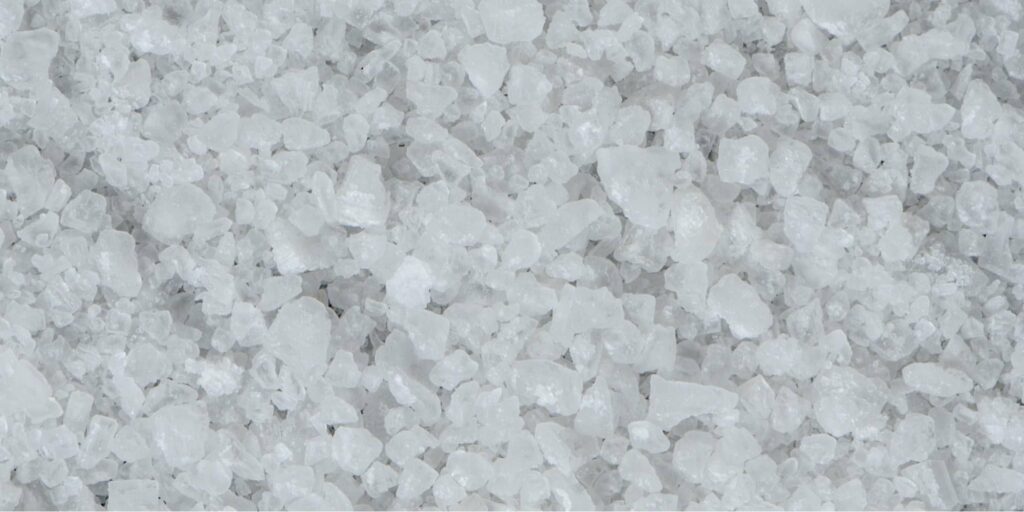If you don’t have an outdoor space to grow your tomatoes, don’t fret! With the right environment and proper nurturing, tomatoes can thrive in pots, too.
Read on for a complete guide on growing tomatoes in pots, so you’ll be able to enjoy homegrown tomatoes at home.
The General Rule for Growing Tomatoes in Pots
Rule of thumb is the bigger the pot, the better! Water every morning and ensure 6-8 hours of sunlight daily.
Trim the first few bottom leaves and dig a hole deep enough so that most of the seedling is buried in high-quality potting soil. Provide support via tomato cages, trellises, or stakes.
How tall do tomato plants grow in pots?

As mentioned earlier, tomato plants can grow anywhere from 3 to 12 feet high. To expect the amount of growth your tomato will have, you’ll need to check whether the kind of tomato variety you’re planting is a determinate or indeterminate tomato.
What are determinate tomato varieties?
Determinate tomato varieties are those that grow at a fixed size. In other words, after they’ve reached maturity, they won’t continue growing. Hence, they’re often called “bush tomatoes”.
These include:
- Anahu
- Celebrity
- Roma
- Rutger
What are indeterminate tomato varieties?
Indeterminate tomato varieties are those that continue to grow despite already bearing fruit. Hence, they’re often called “vine tomatoes”.
These include:
- Bush early girl
- Cherry
- Heirloom
- Goldie
How do I choose the right pot for my tomato variety?

Did you know that tomato plants can grow from 3 to 12 feet high? So, here are a couple of things to consider when choosing the right pot.
Regardless of the type of tomato you’re planting, the bigger the pot, the better.
Tomato plants need a ton of support to carry the weight of their juicy fruits. As climbers, they’ll need assistance from structural support systems.
Hence, you’ll need a big pot to comfortably accommodate your plant’s growing roots and structural support.
Check your pots for adequate drainage.
Without this, constantly moist soil will suffocate the roots, causing root rot which will kill your plant.
So, keep an eye out for pots that have holes at the bottom for excess water to escape. You can also put your pot onto a tray to catch the excess water.
What kind of potting soil should I use for my potted tomatoes?

Using high-quality nutrient-rich potting soil is essential to ensure a great foundation for healthy and optimal plant growth.
Purchasing potting soil? Make sure to check that these ingredients are included:
- Peat Moss
- Perlite
- Pine bark
- Rice hulls
- Manure
- Vermiculite.
Good-quality potting soil should be fluffy and airy, too. The bag should feel soft and lightly packed.
How deep should I plant my seedling into the pot?

Unlike other plants that only need to be potted a few inches deep into the soil, tomato stems are quite frail, which means they need as much support as they can get.
Here’s a nifty trick to help your tomato plant develop a healthier root system:
Trim the first few bottom leaves and dig a hole deep enough so that most of the seedling is buried in the soil.
This will promote the growth of more roots, giving your plant a stronger root system to support itself.
What kind of support do my potted tomatoes need?

As your tomato plant begins to bear fruit, the weight of these bright red orbs can be too much for the stem, causing the plant to droop.
There are several things you can use to give your plants additional support. These include:
- Stakes – This is the sturdiest, easiest, and most cost-effective solution as you can use a variety of materials, such as wood, bamboo, and metal. Simply tie your plant loosely to the stake as it continues to grow.
- Fences – This is another lightweight alternative to stakes and can easily be set up. Both wire and nylon fencing works well to support these climbers.
- Cages – A popular choice among beginners, cages (row 6 – tomato cages) are easy to find at any local market.
However, they tend to topple over once your plants get too heavy. So, it’s best to purchase cages made out of more durable material, but be prepared to pay quite a heft price for it.
- Trellises – Popular among farmers, trellises are great for maximum production rates. However, they’re quite costly and tricky to install.
Nevertheless, they’re quite durable and will last you several harvesting seasons, which makes them ideal for long-term use.
How often should I water my potted tomatoes?

Did you know that plants in pots and containers tend to dry out quicker than those in-ground? Since it’s no secret that tomatoes are made of mostly water, watering correctly is key to ensuring they’re plump and juicy.
Underwatering will cause your plant to dry out, overwatering will promote root rot, and inconsistent watering will result in cracks on your tomatoes.
So, while easy enough to do, improper watering can be detrimental to your plant’s health.
How do you water properly, then? Keep these tips in mind:
Tip #1: Water your tomato plants deeply in the morning. This means that you continue watering until excess begins to drain out.
Tip #2: During warmer months, you can opt to water your plant twice – once in the morning and a second time early in the afternoon.
How often should I give my tomatoes sun?

Tomato plants love sunny spots and need around 6 to 8 hours of sunlight daily, ideally between 10 AM to 4 PM, to thrive.
However, keep in mind that younger plants are a tad more sensitive. So, acclimate them slowly by gradually increasing the amount of time they get sun daily.
Here’s a sample timeline you can use:
- Start off by leaving your plant in a shady area, away from direct sunlight for an hour or two.
- After around 3 to 5 days: raise the exposure by leaving your tomato plant out to receive a few hours of the morning sun. During afternoons, bring your tomatoes in for some rest before repeating them for the next few days.
- After about a week: your tomato may be ready to receive full sun and be left overnight.
Constantly monitor your plant to see whether it’s taking well to the acclimation process. If it’s showing negative signs such as withering leaves, so they may need more time in between exposures to properly acclimate.
How often do I need to fertilize tomatoes in pots?

While most potting soil already has fertilizers in them, frequent watering washes away important nutrients in the soil that your tomato plants need.
Since tomatoes are considered heavy feeders, it’s important to ensure that their soil is rich in supplements, especially during the growing season.
Here are a couple of tips to keep in mind:
Tip #1: You can add a handful of all-purpose slow-release fertilizer or tomato-specific fertilizers when planting. Follow the instructions on the packet for guidance on proper application.
Tip #2: For mature tomato plants, opt for fertilizers that have lower levels of nitrogen and higher levels of phosphorus and potassium. While nitrogen will give you healthy and luscious leaves, you won’t see as much fruit.
There you have it, folks – a complete guide to growing tomatoes in pots! Do you have any tried and tested tricks you think we should include in our list? Let us know!





